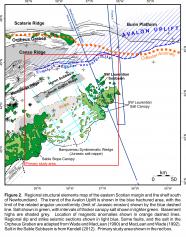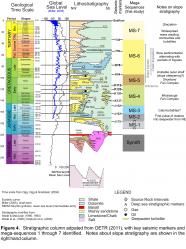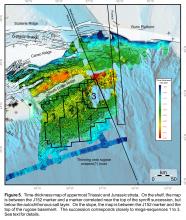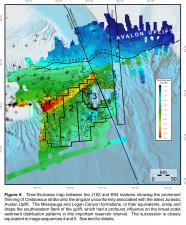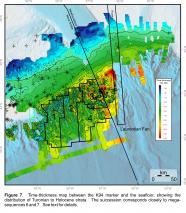Post-rift Sedimentation
Post-rift Sedimentation
Areas of thick salt accumulation on the shelf profoundly influenced later sedimentation, with salt expulsion accommodating thick successions of postrift Jurassic strata seaward of the Canso Ridge (Kendell, 2012; CNSOPB, 2013). The general distribution of Jurassic strata is illustrated nicely in figure 5. Immature Early to Middle Jurassic continental clastic sediments of the Mohican Formation (Wade and MacLean, 1990) were the first to load the salt (Fig. 4). This was followed by a mixed Upper Jurassic succession of alternating shallow marine clastics and carbonates that prograded across the eastern Scotian Shelf towards the South Griffin Ridge, ultimately filling the Huron Subbasin (corresponding to the Mic Mac Formation; MacLean and Wade, 1992).
The “Banquereau Synkinematic Wedge” (BSW) – a widespread salt detachment system (Shimeld, 2004) – developed on the continental slope seaward of the South Griffin Ridge (Fig. 2). It forms an anomalous ~130 km wide by ~150 km long and up to 4.5 km thick wedge of slope strata displaying landward-dipping, sigmoid-shaped reflectors that sole out into a regional salt detachment (Ings and Shimeld, 2006; Albertz et al., 2010; this study). Two different interpretations have been proposed for its timing. Ings and Shimeld (2006) followed by Albertz et al. (2010) interpret the BSW as a primarily Middle to Upper Jurassic element that is time-equivalent to the Mic Mac Formation. In this scenario, the top Jurassic marker is correlated above the BSW, and the BSW largely pre-dates the latest Jurassic development of the Avalon Uplift (see below). In contrast, OETR (2011) interpret the BSW as a Berriasian feature that is largely time-equivalent to the lower parts of the Missisauga Formation. In this scenario, the near-top Jurassic marker (J150) is carried below the BSW, and the BSW is largely synchronous with the Avalon Uplift (and records a period of accelerated slope sedimentation in response to accelerated shelf erosion). We favour carrying our near-top Jurassic marker above the BSW, in agreement with Ings and Shimeld (2006) and Albertz et al. (2010) (as discussed in more detail in a later section).
Although final break-up with Morocco probably took place in the Early Jurassic (Jansa and Wade, 1975b; Keen and Beaumont, 1990; Wade and MacLean, 1990; Labails et al., 2010; Sibuet et al., 2012), the eastern Scotian margin continued to experience the effects from younger rifting to the north. Rejuvenated rifting between the Grand Banks and Iberia in the latest Jurassic was accompanied by widespread uplift along a broad basement arch known as the “Avalon Uplift” (Jansa and Wade, 1975). This prominent basement element, which roughly parallels the SW Grand Banks transform margin, extended across the southern Grand Banks and onto the Burin Platform (Fig. 2). Widespread erosion of the Avalon Uplift led to the development of a prominent angular unconformity and penneplain surface (the “Avalon Unconformity” of Jansa and Wade, 1975) that is clearly recognized on reflection seismic profiles. Jurassic and older strata were heavily eroded along this unconformity, especially north of 45° latitude (Fig. 2). Erosional truncation of Upper Jurassic strata has been traced as far west as the Canso Ridge (MacLean and Wade, 1992; this study). Likewise, the southwestern flank of the Avalon Uplift was onlapped by clastic-dominated Tithonian to Barremian fluvial-deltaic sediments of the Missisauga Formation during several transgressive-regressive cycles (Wade and MacLean, 1990). Aggradation and progradation of interbedded sandstone and shale units continued into the Cenomanian as the Logan Canyon Formation was deposited on a broad coastal plain and shallow shelf, with its more shale-prone basinal equivalent referred to informally as the “Shortland Shale” (Wade and MacLean, 1990). Pronounced thinning continued while the Logan Canyon Formation was deposited, and a combined thickness map of the Missisauga and Logan Canyon formations demonstrates the far-reaching and long-lived influence of the Avalon Uplift, even on the Scotian margin (Fig. 6).
In the Late Cretaceous through Eocene the margin was dominated by accumulations of pelagic chalks and marine shales that developed seaward of several shifting deltas that were largely perched on the shelf, landward of the continental shelf edge (Fensome et al., 2008; Smith et al., 2010; Weston et al., 2012; Deptuck and Campbell, 2012). The remaining post-Eocene succession is complex, with significant Miocene and Oligocene unconformities recorded on a shelf dominated by siliciclastics, and numerous mass transport deposits on the slope and abyssal plain that interfinger with contourites and turbidites (e.g. Campbell, 2011; Campbell and Deptuck, 2012; Piper et al., 2012) (Fig. 7)

